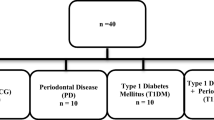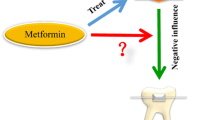Abstract
The mineral content of tooth hard tissue may influence the rate of decay change. Considering this fact, we aimed at examining if type 1 diabetes might be a contributing factor to the appearance of tooth decay. The experiment was conducted on female Wistar rats. To induce diabetes, rats were intravenously injected with 1 mL streptozocine 0.01 M citrate buffer. The control group of rats was injected with 1 mL 0.01 M citrate buffer only. After 10 days, teeth and blood serum samples were obtained. Fluoride concentration was determined by potentiometer method, and calcium and magnesium, by AAS. Serum concentrations of glucose and estradiol in the diabetic rats were significantly higher compared to the control group. In the experimental group, a statistically significant decrease of fluorine concentration in both teeth and serum were observed. Calcium and magnesium concentrations in blood serum and dental magnesium concentration were significantly higher in rats with type 1 diabetes compared with the control. A downward trend in the content of dental calcium in streptozotocin-induced diabetic rats was observed. The results obtained indicate that caries initiation and progression could be promoted by metabolic changes associated with diabetes affecting the mineral composition of tooth hard tissue.




Similar content being viewed by others
References
Buczkowska-Radlińska J (1999) Modifiers of de- and remineralization of enamel in teeth, in the context of susceptibility to caries. Habilitation dissertation, Pomeranian Medical University, Szczecin
Zero DT (1996) Etiology of dental erosion—extrinsic factors. Eur J Oral Sci 104:162–177
Charles MA, Fantbonne A, Warnet JM et al (1991) Risk factors for NIDDM in white population. Diabetes 40:796–799
Madejczyk M, Bachanek T (2001) Oral health of patients with diabetes mellitius—review of literature. Wiad Lek 54:556–561
Twetman S, Aronsson S, Bjorkman S (1989) Mutans streptococci and lactobacilli in saliva from children with insulin-dependent diabetes mellitus. Oral Microbiol Immunol 4:165–168
Ackerman DM, Leibman KC (1977) Effect of experimental diabetes on drug metabolism in the rat. Drug Metab Dispos 5:405–410
World Health Organization (1994) Fluorides and oral health. WHO Technical Raport Series 846, Genewa
Medsen KL, Parler VM, Fedorak RN (1993) Oral vanadate reduces Na+-dependent glucose transport in rat small intestine. Diabetes 42:1126–1132
Mordes JP, Rossini AA (1981) Animal models of diabetes. Am J Med 70:353–360
Agarwal MK (1980) Streptozotocin; mechanism of action. FEBS Lett 120:1–3
Skett P, Joels LA (1985) Different efects of acute and chronic diabetes mellitus on hepatic drug metabolism in the rats. Biochem Pharmacol 34:285–289
Collin H, Uuistupa M, Niskanen L, Koivisto A, Markkanen H, Meurman J (1998) Caries in patients with non insulin dependent diabetes mellitus. Oral Surg Oral Med Oral Pathol Oral Radiol Endo 85:680–685
Enbland E, Lundin S, Sjodin Aman L (2001) Caries and salivary status in young adults with type 1 diabetes. Swed Dent J 25:53–60
Loe H (1993) Periodontal disease: the sixth complication of diabetes mellitus. Diabetes Care 16:329–334
Twetman S, Nederforst T, Stahl B et al (1992) Two years longitudinal observations of salivary status and dental caries in children with insulin dependent diabetes mellitus. Pediatr Dent 14:184–188
Orbak R, Simsek S, Orbak Z et al (2008) The influence of type-1 diabetes mellitus on dentition and oral health in children and adolescents. Yonsei Med J 49:357–365
Atar M, Atar-Zwillenberg DR, Verry P et al (2004) Defective enamel ultrastructure in diabetic rodents. Int J Peadiatr Dent 14:301–307
Jańczuk Z, Szymaniak E (1994) Dental caries. PZWL, Warsaw
Kautsky MB, Featherstone JD (1993) Effect of salivary components on dissolution rates of carbonated apatites. Caries Res 27:373–377
Piątowska D (2002) Dryft of cariology. Med Tour Press International, Warsaw
Kaczmarek U (1986) Fluorine and some saliva components and caries. Habilitation dissertation. Medical University, Wrocław, Poland
Jakubowska K, Chlubek D, Łagocka R et al (2004) Fluoride concentration in superficial enamel layers of permanent teeth in children residing in areas with different levels of environmental pollution with fluorine compounds. Environ Sci 11:337–344
Grocholewicz K, Tomasik M, Chlubek D et al (2002) Changes in the concentration of fluorides in saliva after the use of fluoride tooth-paste. Met Fluorine 96–101
Ignacak J, Gumińska M (1996) Urine fluoride assessed with the ion-selective method as a measure of human exposure to various fluorine compounds. Met Fluorine 19–22
Gutowska I, Baranowska-Bosiacka I, Rybicka M et al (2009) Changes in the concentration of fluoride and biogenic elements in the serum and bones of female rats with streptozotocin-induced diabetes. Fluoride 42(1):11–18
Aoba T (2004) Solubility properties of human tooth mineral and pathogenesis of dental caries. Oral Dis 10:249–257
Fejerskov O, Kidd E (2006) Caries. Caries and clinical conduct. Medical Publisher Urban & Partner, Wrocław
Tenuovo J (1997) Salivary parameters of relevance for assessing caries activity in individuals and populations. Comm Dent Oral Epidem 25:82–86
Książek K, Wiśniewska J (2001) Participation of glucose and reactive forms of oxygen in the formation of vascular complications of diabetes. Przegląd Lek 58:915–918
Torres MD, Canal JR, Perez C (1999) Oxidative stress in normal and diabetic rats. Physiol Rev 48:203–208
Sinclair AJ (1993) Free radical mechanism and vascular complications of diabetes mellitius. Diabet Rev 2:7–10
Maridonneau I, Braguet P, Garay RP (1983) Na+, K+ transport damage induced by oxygen free radicals in human red cell membranes. J Biol Chem 258:3107–3113
Le May C, Chu K, Hu M et al (2006) Estrogens protect pancreatic β-cells from apoptosis and prevent insulin-deficient diabetes mellitus in mice. PNAS 103:9232–9237
Murray RK, Granner DK, Mayes PA et al (2006) Harper’s biochemistry. Appleton and Lange, Stamford
Hough S, Slatopolsky E, Avioli LA (2006) Hormonal alterations in experimental diabetes: role of a primary disturbance in calcium homeostasis. Calcif Tissue Int 35:615–619
Paul S, Mukherjee D, Pramanick K et al (2008) Stimulation of salmon calcitonin on secretion of 17beta-estradiol by the ovarian follicles of common carp, Cyprinus carpio. J Endocrinol 196:413–424
Durlach J (1991) Magnesium in clinical practice. PZWL, Warszawa
Author information
Authors and Affiliations
Corresponding author
Rights and permissions
About this article
Cite this article
Gutowska, I., Baranowska-Bosiacka, I., Rybicka, M. et al. Changes in the Concentration of Microelements in the Teeth of Rats in the Final Stage of Type 1 Diabetes, with an Absolute Lack of Insulin. Biol Trace Elem Res 139, 332–340 (2011). https://doi.org/10.1007/s12011-010-8666-5
Received:
Accepted:
Published:
Issue Date:
DOI: https://doi.org/10.1007/s12011-010-8666-5




